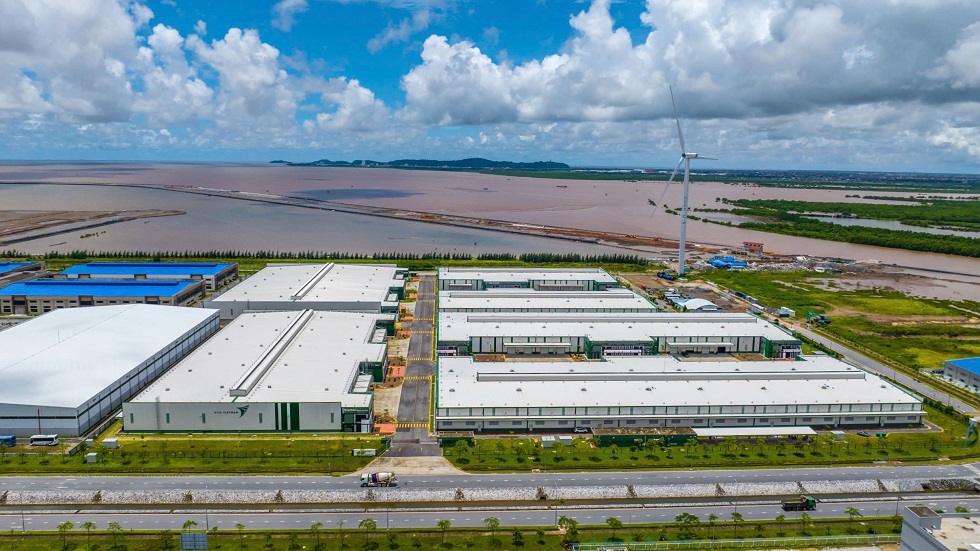The demand for ready-built warehouses in Vietnam, particularly in international logistics hubs, is gaining momentum as industrial real estate developers increasingly invest in modern and eco-friendly facilities.
Warehouse demand rebounds
In the second quarter of this year, the industrial real estate sector, particularly the warehouse segment, showed signs of strong recovery. Demand and rental prices are projected to rise in the coming months.
According to a report by market research firm Cushman & Wakefield, the net absorption rate for warehouses in the northern key economic region nearly doubled compared to the previous quarter and tripled from last year.
The northern port city of Haiphong, a gateway to the region, led warehouse demand this quarter, accounting for 51% of total net absorption. Bac Ninh, another key industrial province, followed with 31%.
Developers are continuing to pour capital into ready-built warehouses and factories. In early August, KCN Vietnam Group broke ground on phase two of its project in the Deep C Industrial Park in Haiphong, adding over 80,000 square meters of high-quality warehouse, hybrid (mixed-use between factories and warehouses) space for the logistics sector.
Similarly, three new ready-built warehouse projects were launched in the second quarter, including the BW’s Vietnam Singapore Industrial Park Bac Ninh 2 project, the LOGOS Yen Phong 2A project, and KCN Vietnam’s Thuan Thanh 3B project. All the three, located in Bac Ninh Province, will contribute over 277,000 square meters of new supply to the market.
KCN Vietnam Group said that Haiphong City has significant strategic advantages in attracting investment in high-tech industries, manufacturing, and logistics. The city’s ambition to become a modern international logistics hub positions it well to store and distribute both local and international goods, helping investors optimize their supply chains.

The recovering export-import sector and manufacturing activities in the second quarter were key drivers of warehouse demand in the northern key economic region, according to Cushman & Wakefield. In the southern market, demand was driven by the rebound in production, consumption and trade.
While average warehouse rental prices in northern Vietnam decreased by 1% year-on-year in the first half of 2024, those in the south edged up by 2%. However, Cushman & Wakefield predicts that average rental prices will continue to rise by 0-3.5 percentage points annually between 2024 and 2026.
Demand driven by investment and trade
The demand for warehouses in Vietnam is rebounding as investment and trade flows are continuing to rise.
According to the General Statistics Office, the total import-export turnover in the first seven months of 2024 rose by 17.1% over the same period last year. Notably, exports picked up by 15.7%, resulting in a trade surplus of over US$14 billion. This increase in production and trade is leading businesses to choose international logistics hubs in Vietnam to optimize costs.
The demand for warehouses is also being driven by the ongoing growth of e-commerce. A report by Momentum Works, titled “E-commerce in Southeast Asia 2024,” indicates that Vietnam’s e-commerce sector has been growing at an annual rate of 16-30%, with gross merchandise value (GMV) last year surging by 52.9%. This growth has positioned Vietnam as the third-largest e-commerce market in Southeast Asia.
With rising consumer demand, investors, including e-commerce platforms and delivery companies, are seeking warehouses in strategic locations, particularly for last-mile delivery in major cities. These warehouses need to be large and equipped with advanced technology for operations, from warehouse management to delivery. In the southern region, there have been many modern ready-built warehouses dedicated to e-commerce platforms like Shopee and delivery companies like Best and J&T Express.
As a result, the demand for high-quality warehouses is expected to continue increasing, especially those that meet “green” standards or serve as international logistics centers rather than just domestic ones. This not only gives investors and goods owners a cost advantage but also promotes sustainable development.

Cushman & Wakefield also noted a flexible shift between ready-built warehouses and factories is emerging. Some developers are converting surplus warehouse space into ready-built factories, which are seeing increased demand due to rising FDI inflows into Vietnam. As warehouse demand rebounds, this trend offers more options for investors.
Overall, investment in warehousing is becoming increasingly critical as part of establishing supply chains. A good warehouse must meet storage needs and ensure the quality of goods delivered to customers. However, it must also fulfill other criteria, such as strategic location for international and domestic deliveries, high technology integration, and adherence to green standards. The growing focus on sustainable development among businesses will further drive warehouse demand in the coming years.









